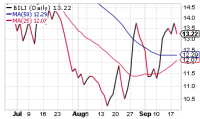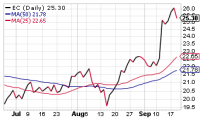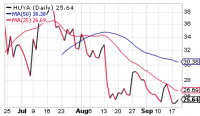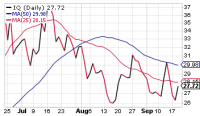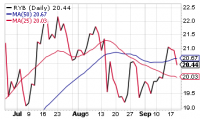The world isn’t providing much good news for emerging market stocks to build on, but the stocks themselves are doing a good job of ignoring that. This doesn’t mean that we have a new buy signal, but there are a growing number of stocks that are putting in bottoming structures and even a few making some progress. With the market looking ahead, we could start to see new leaders emerge in the next few weeks or after EM companies report their quarterly results in a couple of months. There will be plenty of bargains when the turn comes, and we’re featuring an old friend that been in the doldrums for quite a while but boasts a huge story. Read on for all the details.
Cabot Emerging Markets Investor 668
[premium_html_toc post_id="159731"]
Cabot Emerging Markets Timer
The Emerging Markets Timer is our disciplined method for staying on the right side of the emerging markets. The Timer is bullish when the index is above the lower of its two moving averages and that moving average is trending up.
The intermediate-term trend remains down, but we’ve seen some solid signs of resilience from our Emerging Markets Timer lately. Despite some terrible sentiment (big money managers are more underweight EM stocks than they have been in years), the iShares EM Fund (EEM) has found support in the 41 to 43 area three times since late June and recently popped back above its lower (25-day) moving average.
It’s a good start and worth watching, though we’ll probably need a rally of another point or so in the near-term to get a green light. If it happens, there should be a ton of lucrative opportunities, but right now, it’s best to remain defensive and patient, seeing if this upmove is the real McCoy.
Drip, Drip, Drip
On Monday, President Trump imposed a 10% tariff on another $200 billion of Chinese imports, effective September 24, with a threatened increase to 25% in January if there are no concessions from China. That’s on top of a 25% tariff already placed on $50 billion of Chinese goods and the imposition by China of an identical set of retaliatory tariffs.
There has been an Imperial ton of analysis about what effect these tariffs may have on the economies of both China and the U.S., strategic speculation about what U.S. goods might be targeted by the Chinese in response to the latest round of U.S. trade sanctions, political prognostication about how the trade war might effect the upcoming U.S. mid-term elections and legal opinionizing on the ethical issues involved.
Ten years from now, this whole contest of wills will no doubt be the subject of a short shelf of books about winners and losers, consequences and aftereffects. And one half of them will contradict the other half.
But I really don’t care.
What I care about is that the escalation of the trade war between the U.S. and China has met an unexpectedly cheerful response from investors. The iShares EM Fund (EEM) took a small step lower on Monday, but popped higher on Tuesday and Wednesday, actually getting back on top of its 25-day moving average on Wednesday. And while the reaction from the Golden Dragon ETF (PGJ) wasn’t quite as strong, it was also decidedly positive.
There is speculation that Monday’s 10% tariff round on $200 billion of goods was already priced into the market. And since the market is always looking into the medium-term future, that makes sense.
But what investors are seeing in the future that caused them to push Baidu (to use one example) higher by 5% on Wednesday is a bit obscure. It may be that the stock’s double bottom at 210 on August 15 and September 11 triggered some buying activity. Baidu has always been a long-term favorite of mine, but its chart hasn’t sent a useful signal since the middle of October 2017.
Or, it may be that investor sentiment about emerging markets is actually ready to turn positive. Just recently, Merrill Lynch, JP Morgan and Bank of America have all issued positive messages about Chinese stocks. And while their rationales for optimism differ (one likes the fundamentals, two are looking for the Chinese government to kick-start economic growth via fiscal stimulus), the shift in perception is undeniable. These whales are especially enthusiastic about the Chinese tech stocks (Alibaba, Baidu, iQIYI, etc.) that have been beaten down for a long time.
My own opinion just shows how boringly consistent I am in my approach to emerging market stocks. I believe in what I see in the charts. When the news tells me that institutional investors are moving back into EM stocks, I take it with a grain (or five) of salt. When the charts tell me that EEM is back on top of its lower moving average (which is the 25-day right now) and that the average is trending up (hasn’t happened yet), that’s when I will do the small victory dance and start to increase the portfolio’s exposure.
But not before.
Featured Stock
Still Baidu After All These Years
Baidu (BIDU)
While it’s always nice to find a brand-new stock that’s climbing the charts, sometimes the best choice is a familiar name that’s been in the doghouse for a while. And that description fits Baidu to a T.
Baidu has always been a headline stock, taking a high-profile position as “the Google of China” right from the beginning, then besting Google in head-to-head competition by giving better search results in its home country. Baidu’s superior understanding of the intricacies of the Chinese language was the primary reason for its dominance in online search.
But the company was slow to recognize the massive shift to mobile devices among Chinese internet users, and that allowed upstarts to steal chunks of its market share. It took Baidu a long time to recover its leadership position, but the corporate makeover was probably a good thing in the long run.
Baidu has always offered a much richer menu of services to Chinese users, including image and video search, news/weather/sports information, maps, payments, education, investments and a personal cloud platform, among others. A huge majority of the company’s services are offered for free, with revenue coming from the same source as Google, online advertising services based on keyword searches.
The company has a history of profitability that dates back to 2004, with earnings going up every year but 2015. That’s the year when Baidu pumped a ton of its free cash flow into development projects like artificial intelligence, self-driving cars and strategic investments in complementary businesses and speculative startups. Those investments are just now starting to pay off, as revenue growth, which slowed to 1% in 2016, advanced by 20% in 2017 and by 36% and 27% in the first two quarters of 2018. The company has also enjoyed triple-digit earnings growth in two of the last four quarters, including 107% in Q1 and 59% in Q2. Analysts are forecasting EPS growth of 12% this year and 14% in 2019 (both likely conservative).
One major accomplishment of the company’s development efforts was iQIYI, the video streaming service that was spun off in March 2018 and which we added to our portfolio in May. Baidu retains a majority stake in iQIYI.
BIDU hasn’t been the easiest stock to buy over the years. We first had it in the portfolio back in 2006, when the company had been public for just over a year and was recovering from its post-IPO droop from a high of 15 in August 2005 to 4.4 in February 2006. The rebound from that low was the first of the stock’s big runs, topping out at 43 in late 2007. A correction to 10 in December 2008 gave way to a monster rally that seemed to run forever, reaching 166 in July 2011. A somewhat gentler correction to 83 in April 2013 bloomed into another rally, this time to 252 in November 2014.
But since that all-time high, there hasn’t been a persistent rally in BIDU. We made a little money in the stock from our most-recent buy in August 2017, but since then there has just been too much sideways movement to get bullish.
We’re featuring Baidu today not because its stock is hugely strong, but because it has been trading sideways since October 2017. BIDU is trading right around 230, having run into resistance in the 270s since March, with one brief poke above that level in May that evaporated quickly. The stock has found support around 210 several times during its long consolidation period, and there has been no diminution of its support from institutional investors.
BIDU will be a high-quality addition to our watch list, and we will be alert for any signs of swelling investor support. The company’s next quarterly report—probably just before Halloween—may be just the catalyst that the stock needs. We’ll keep it rated Watch until we get the go ahead. WATCH.
Baidu (BIDU)
Baidu Campus
No 10, Shangdi 10th Street Haidian District
Beijing 100085
China
www.baidu.com
Model Portfolio
Invested 30% Cash 70%
Updates
It’s still not pretty among emerging market stocks, but we’re encouraged by the resilience shown during the past month or two—you really can’t have a worse environment for the sector. But the iShares EM Fund (and, to a lesser extent, the China Golden Dragon Fund) have at least shown a willingness to bounce on bad news.
We’re not trumpeting sunshine, of course—with the trend down, we remain very defensive, with 70% in cash, and even if we get a new buy signal in the weeks ahead, we’re likely to go slow. But at this point, with so much in cash and with so much bad news out there, it’s time to keep your eyes open and be ready for any new upturn that occurs.
Tonight, we’re moving Ecopetrol (EC) to a Buy a Half rating.
Alibaba (BABA) has finally found some support in the mid 150s, bouncing decently during the past week (though its still below its moving averages). The company still has its hands in many cookie jars—it announced it’s forming a semiconductor subsidiary to make customized AI chips—which probably isn’t ideal, as big investors are focused on growth and earnings, not promises of the future. Still, BABA is as dominant a red chip stock as we’re going to get in China (and all emerging markets), and we expect it to have a good run once the pressure comes off the group. Encouragingly, earnings estimates have recently been hiked, with analysts looking for 13% growth this fiscal year (ending March 2019) and 35% next. HOLD.
BeiGene (BGNE) hasn’t bounced with most Chinese stocks during the past week, but it also didn’t get taken apart during the past few months. The company released another small batch of positive clinical data results this morning, but it really didn’t move the stock. A drop into the 150 area would be a red flag, but right here, we’re OK nibbling if you want in. BUY A HALF.
Bilibili (BILI) is in great position to be a new leader should EM and China stocks get going—shares have acted very well since gapping up on earnings late last month, including a nice-volume pop higher last week and some tightness after Bilibili bought a minority stake in a Japanese animation production studio. Keep this one near the top of your watch list. WATCH.
Ecopetrol (EC) has held on to its monster upmove from last week, which is a good sign the breakout will stick. Of course, if oil prices fall or if something goes haywire in Colombia, the stock would probably react. But business is good (oil output in Q2 was the highest in two years) and the stock looks ready to move. We’ll move the rating to Buy a Half. BUY A HALF.
Huya Inc. (HUYA) is still worth watching, and it has shown some solid bottoming action during the past month (including some bullish buying volume clues in late August and last week). But we’d watch to see the buyers push the price higher before considering it seriously. WATCH.
iQIYI (IQ) is the third recent IPO we’re interested in and we have a nice profit in our half position. IQ is probably a bit better-looking on the chart than HUYA, but not as good (as of now) as BILI. The company recently took a stake in Eros, an Indian movie streaming service with 10 million subscribers, similar to a deal iQUYI inked with Netflix last year. Continue to hold your half position as the stock is holding support. HOLD A HALF.
RYB Education (RYB) remains in its trading range, which is fine by us given the market environment and the wretched performance of some larger education peers. Similar to BGNE, we’re OK nibbling here if you want in. BUY A HALF.
WNS Holdings (WNS) doesn’t provide much drama—its business has expanded for years as demand for its business services steadily rises. It’s not going to be the fastest horse, but WNS’s consolidation since early July should make for a good launching pad once EM stocks turn up. WATCH.
[premium_html_footer]
Send questions or comments to paul@cabotwealth.com.
Cabot Emerging Markets Investor • 176 North Street, Salem, MA 01970 • www.cabotwealth.com
All Cabot Emerging Markets Investor buy and sell recommendations are made in issues or updates and posted on the Cabot subscribers’ website. Sell recommendations may also be sent to subscribers as special alerts via email. To calculate the performance of the hypothetical portfolio, Cabot “buys” and “sells” at the midpoint of the high and low prices of the stock on the day following the recommendation. Cabot’s policy is to sell any stock that shows a loss of 20% in a bull market (15% in a bear market) from our original buy price, calculated using the current closing (not intra-day) price. Subscribers should apply loss limits based on their own personal purchase prices.
THE NEXT CABOT EMERGING MARKETS INVESTOR ISSUE IS SCHEDULED FOR October 4, 2018
We appreciate your feedback on this issue. Follow the link below to complete our subscriber satisfaction survey: Go to: www.surveymonkey.com/chinasurvey
Cabot Emerging Markets Investor is published by Cabot Wealth Network, an independent publisher of investment advice since 1970. Neither Cabot Wealth Network, nor our employees, are compensated in any way by the companies whose stocks we recommend. Sources of information are believed to be reliable, but they are in no way guaranteed to be complete or without error. Recommendations, opinions or suggestions are given with the understanding that subscribers acting on information assume all risks involved. © Cabot Wealth Network 2018. Copying and/or electronic transmission of this report is a violation of the copyright law. For the protection of our subscribers, if copyright laws are violated, the subscription will be terminated. To subscribe or for information on our privacy policy, visit www.cabotwealth.com, write to support@cabotwealth.com or call 978-745-5532.
[/premium_html_footer]







